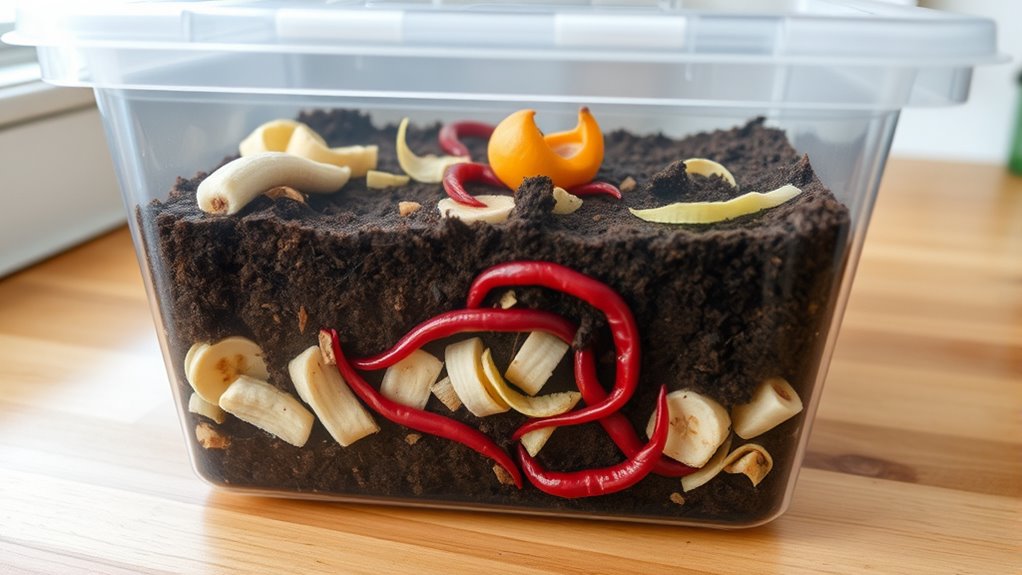To create a worm compost bin for kitchen waste, choose a container with good drainage and aeration. Layer shredded newspaper or cardboard with some damp bedding, then bury food scraps like fruit and vegetable peels under the bedding. Keep the bin in a shaded spot at temperatures between 55°F and 77°F, and avoid overfeeding. Regularly check moisture levels and turn the bedding for healthy, efficient composting—continue exploring to learn more about successful vermicomposting.
Key Takeaways
- Choose a well-drained, aerated container with a lid to house your worms comfortably.
- Layer bedding materials like shredded newspaper or cardboard, keeping it moist but not soaked.
- Bury kitchen scraps beneath bedding to reduce odors and pests.
- Use red wiggler worms (Eisenia fetida) for efficient composting; avoid earthworms not suited for composting.
- Maintain temperature between 55°F and 77°F and turn bedding regularly for healthy worm activity.

If you want to reduce kitchen waste and create nutrient-rich compost, setting up a worm compost bin is a smart choice. This method, known as vermicomposting, transforms your food scraps into valuable soil amendment while minimizing landfill contributions. To get started, you’ll need to understand some key vermicomposting techniques that guarantee your worms stay healthy and your composting process runs smoothly. One of the most important steps is selecting the right worm species. Not all worms are suitable for composting, so choosing the appropriate ones is vital for success.
When it comes to worm species selection, red wigglers (Eisenia fetida) are the top choice for most home vermicomposting setups. These worms thrive in decomposing organic matter and are excellent at converting kitchen scraps into compost quickly. They’re resilient, adaptable, and reproduce rapidly, making them perfect for beginners. Avoid using earthworms like nightcrawlers, as they prefer soil environments and won’t perform well in a bin filled with food waste and bedding material. Proper worm species selection guarantees your composting process remains efficient and your worms stay healthy.
Vermicomposting techniques involve creating the right environment within your bin. You’ll want to set up a container with good drainage and aeration to prevent excess moisture and odors. Layering bedding materials such as shredded newspaper, cardboard, or coconut coir provides a comfortable habitat for the worms. Keep the bedding moist but not soaked, mimicking a damp forest floor. When adding kitchen scraps, chop them into small pieces and bury them beneath the bedding to prevent fruit flies and odors. Regularly turning the bedding helps aerate the bin and distributes moisture evenly, encouraging microbial activity and worm health.
Create a healthy worm bin with proper drainage, bedding, and regular turning for optimal composting.
Monitoring the bin’s temperature is also essential. Worms thrive between 55 and 77 degrees Fahrenheit, so place your bin in a shaded, draft-free spot. If temperatures fluctuate outside this range, it can stress the worms or slow down the composting process. Feed your worms in small amounts, only adding as much as they can process in a few days, to avoid overfeeding and foul odors. Over time, you’ll notice the bedding darkening and becoming crumbly — a sign that your worms are producing rich compost.
Frequently Asked Questions
How Often Should I Harvest the Compost From My Worm Bin?
You should harvest the compost from your worm bin every 2 to 3 months, depending on the harvest frequency and compost maturity. When the vermicompost looks dark, crumbly, and earthy, it’s ready for harvest. Regular harvesting prevents overfeeding and keeps your worms healthy. Keep an eye on the bin’s activity, and aim to harvest when the compost reaches ideal maturity for the best nutrient-rich soil for your plants.
Can I Add Meat or Dairy to My Worm Compost Bin?
Think of your worm bin as a delicate dance floor; adding meat or dairy is like bringing heavy, disruptive partners. Meat restrictions are strict—avoid them, as they can cause odors and attract pests. Dairy alternatives, like plant-based options, are safer choices that won’t upset the balance. Keep your worms happy by sticking to veggie scraps, and your compost will flourish without the chaos of unwanted proteins.
What Are Signs My Worms Are Unhealthy or Dying?
If your worms show little activity, appear sluggish, or are mostly on the surface, they might be unhealthy or dying. Check moisture levels—if it’s too dry or too wet, worms struggle. Look for a foul smell, which indicates poor conditions. Healthy worms are active, moist, and burrow smoothly through the compost. Adjust moisture and airflow as needed to restore their health and keep your compost thriving.
How Do I Troubleshoot Foul Odors in My Worm Bin?
Foul odors in your worm bin? Time to play detective. Check the air circulation—poor airflow causes stink. Improve it by gently stirring the bedding and ensuring holes are unblocked. Also, assess bedding moisture—too wet and the smell worsens. Add dry bedding like shredded paper or leaves to absorb excess moisture. With proper air flow and balanced moisture, your worms will thrive, and the smell will vanish faster than your excuses.
What Is the Best Location for Placing My Worm Compost Bin Indoors?
You should place your worm compost bin indoors in a cool, dark spot with minimal direct light exposure, like a basement corner or under the sink. Avoid areas with fluctuating temperatures or high humidity. Make certain of good airflow and keep it away from heating vents or direct sunlight. This setup helps maintain the right environment for your worms, keeps odors in check, and promotes efficient composting.
Conclusion
Now that you’ve set up your worm compost bin, you’re turning kitchen waste into a treasure chest of rich soil. Think of your worms as tiny alchemists transforming scraps into gold for your garden. With patience and care, you’ll watch your compost bin thrive, nourishing plants and reducing waste. Your eco-friendly journey is just beginning—embrace it with enthusiasm, because you’re not just composting, you’re creating a greener world, one worm at a time.

